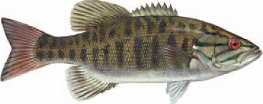 Scientific Name
Scientific Name
Micropterus dolomieu
Other Common Names
Bronzeback, black bass
Identification
Coppery-brown above, with greenish- brown sides with darker vertical bars. Three dark bars radiate from the eye on the cheek and gill cover. Dorsal fin is not as deeply notched as the largemouth. Upper jaw extends back only in line with the middle of the eye. A 4 or 5 lb. fish is considered a trophy.
Best Fishing
Lakes: Claytor, Smith Mountain, Philpott, Moomaw, and South Holston Rivers: James (above the fall line); New; South Fork, North Fork, and mainstem Shenandoah; Rappahannock (above the fall line); Maury; North Fork Holston; and Clinch.
Fishing Techniques
Fly, spinning, spincasting and baitcasting rods
Feeding Habits
Crayfish are a favored prey as are madtoms. Also feeds on adult larval insects such as mayfly nymphs, and hellgrammites, tadpoles and other small fish.
Habitat
Native to Tennessee and Big Sandy River drainage streams of southwest Virginia. Introduced into all major fast-flowing rivers and cool lakes. Prefers clear flowing streams and rivers with rock, bedrock and gravel bottoms and numerous riffles, and cool deep water of large, clear reservoirs with boulders and gravel bottoms. Most active in 67° to 72°F water, and intolerant of silty, warm and polluted water.
Spawning Habits
Males build nests on sand, gravel, or rubble bottom, usually 2 to 4 ft. deep, with spawning in late April to early June as temperatures exceed 60°F. Male guards nest and fry.


